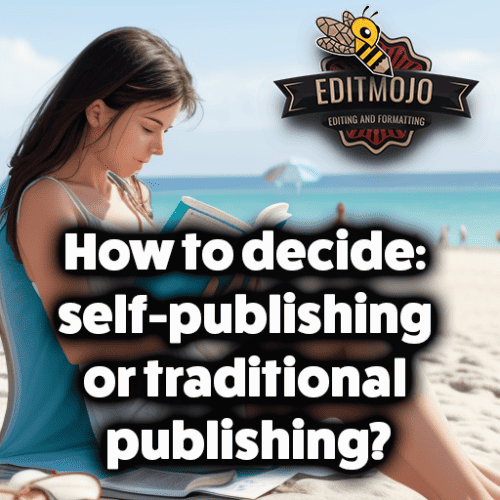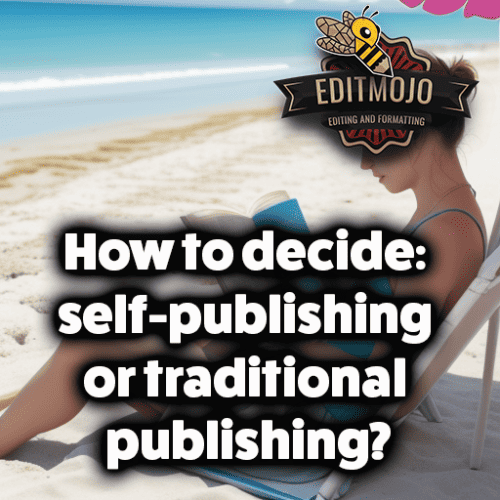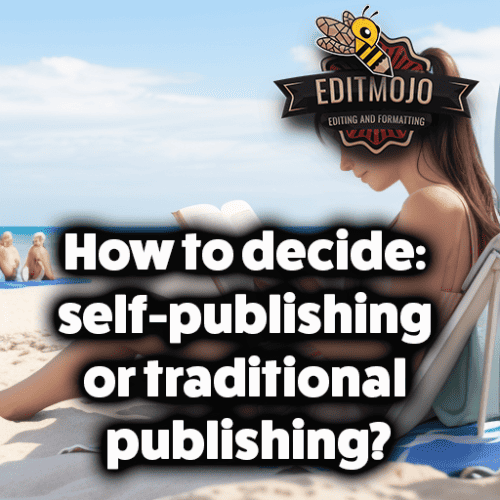How to decide: self-publishing or traditional publishing?
How to decide: self-publishing or traditional publishing? As a writer, one of the biggest decisions you will make on your journey is choosing between self-publishing or traditional publishing. Both have their unique advantages and challenges, and understanding each path can help you decide which option aligns best with your personal goals and writing style.
Key Takeaways
| Traditional Publishing | Self-Publishing |
|---|---|
| Access to professional editing, design, and marketing services | Full control over creative decisions |
| Wide distribution and potential for international rights sales | Higher royalty rates, up to 70% |
| Prestige and advance payments | Faster publishing timeline |
| Lower royalty rates, typically 10% – 15% | Requires significant personal investment |
| Less control over creative aspects, such as cover design and title | Limited distribution capabilities, primarily online |
| Time-consuming, from securing an agent to having the book on shelves | Responsibility for all aspects, including marketing and promotion |
Understanding Traditional Publishing
The Traditional Publishing Process
Traditional publishing involves working with a publishing house that manages the process from manuscript to a finished book. It starts with the grueling task of preparing your manuscript and querying agents. Once you have an agent, they negotiate contracts with publishers on your behalf. The publisher then takes over the editing, design, production, marketing, and distribution of your book.
Pros of Traditional Publishing
Access to Professional Services
With traditional publishing, you gain access to a team of professionals who guide your book from concept to market. These include editors, cover designers, and marketing experts.
Wide Distribution and International Rights Sales
Your book has the potential to reach a global audience. Publishers often have established relationships with booksellers, which can lead to broader distribution and more sales.
Advance Payments and Prestige
Publishers typically provide an advance payment, which can be quite substantial depending on the potential success of your book. Plus, there’s a certain prestige associated with getting published traditionally, as your work has been validated by industry professionals.

Cons of Traditional Publishing
Lower Royalty Rates
With traditional publishing, you may receive lower royalty rates—usually between 10% and 15%.
Less Control Over Creative Decisions
The publisher has the final say on matters like the book’s title, cover design, and sometimes even the content. If creative control is paramount to you, this might be a challenge.
Time-Consuming Process
The traditional publishing route is often long, from securing an agent to seeing your book on shelves. It can take anywhere from 18 months to several years.
Understanding Self-Publishing
The Self-Publishing Process
In self-publishing, you are the publisher. This means writing, editing, cover design, selecting a publishing platform like Amazon KDP, and marketing are all your responsibilities.
Pros of Self-Publishing
Full Control Over Creative Decisions
You have the final say on every aspect of your book, from content to design to pricing.
Higher Royalty Rates
Self-publishing can provide higher royalties—often up to 70%—allowing you to earn more from your book sales.
Faster Publishing Timeline
The timeline from completed manuscript to published book can be much quicker in self-publishing, often within a few months.

Cons of Self-Publishing
Requires Significant Personal Investment
There are costs involved in professional editing, design, and marketing services which you must bear.
Limited Distribution Capabilities
Your book may not reach brick-and-mortar stores, which can limit your distribution.
Responsibility for Marketing and Promotion
You must handle all the marketing and promotion for your book, which can be time-consuming and require a new skill set.
Key Factors to Consider when Choosing Your Publishing Path
Goals for Your Book
What is your ultimate goal for your book? Is it to reach as many readers as possible? To maintain creative control? Or to generate substantial income? Your goals can guide your decision.
Your Personal Skills and Resources
Consider your skills and resources. If you enjoy marketing and have the time to commit, self-publishing might be a good fit. If you’d prefer to focus solely on writing, traditional publishing could be more suitable.
The Genre and Market of Your Book
Certain genres such as literary fiction and non-fiction often thrive in traditional publishing, while others like romance, fantasy, and science fiction can find success in self-publishing. Research your genre’s market to understand where your book might fit best.
Personal Perspectives: Interviews with Authors
Authors who’ve walked these paths can provide valuable insights. Hugh Howey, a successful self-published author, swears by the control and financial benefits of self-publishing. On the other hand, authors like J.K. Rowling, who chose the traditional route, highlight the value of professional support and wide distribution.
Case Studies (How to decide: self-publishing or traditional publishing?)
Successful Traditional Publishing Examples
Authors like George R.R. Martin and Margaret Atwood have seen massive success through traditional publishing, with their books reaching global audiences and even inspiring television adaptations.

Successful Self-Publishing Examples
Amanda Hocking, a paranormal romance author, has sold millions of copies of her self-published books, proving that with the right marketing and audience, self-publishing can be extremely lucrative.
Common Myths and Misconceptions about Publishing
Debunking Traditional Publishing Myths
A common myth is that traditional publishing is the only way to be a “real” author. The reality is that many successful authors choose to self-publish, and the quality and success of a book is determined by its content and its audience, not its publishing method.
Debunking Self-Publishing Myths
There’s a myth that self-publishing is an easy way to get rich quick. However, self-publishing requires a significant amount of work, including writing, editing, marketing, and more.
Conclusion (How to decide: self-publishing or traditional publishing?)
The decision between self-publishing and traditional publishing is personal and depends on your goals, skills, and resources. Both paths can lead to success if navigated with dedication and savvy. The most important thing is to keep writing and make the choice that feels right for you.
Additional Resources
For more information, check out The Business of Being a Writer by Jane Friedman. Online communities like Absolute Write and Writers’ Cafe can also provide invaluable advice and support.
Top Five Questions and Answers
| Questions | Answers |
|---|---|
| What are the main advantages of traditional publishing? | Access to professional services, wide distribution, and prestige. |
| What are the main advantages of self-publishing? | Full creative control, higher royalty rates, and a faster publishing timeline. |
| How long does the traditional publishing process typically take? | From securing an agent to seeing the book on shelves, it can take anywhere from 18 months to several years. |
| What genres are typically successful in self-publishing? | Genres like romance, fantasy, and science fiction often do well in self-publishing. |
| What are the potential downsides of self-publishing? | It requires significant personal investment and responsibility for marketing and promotion. |
